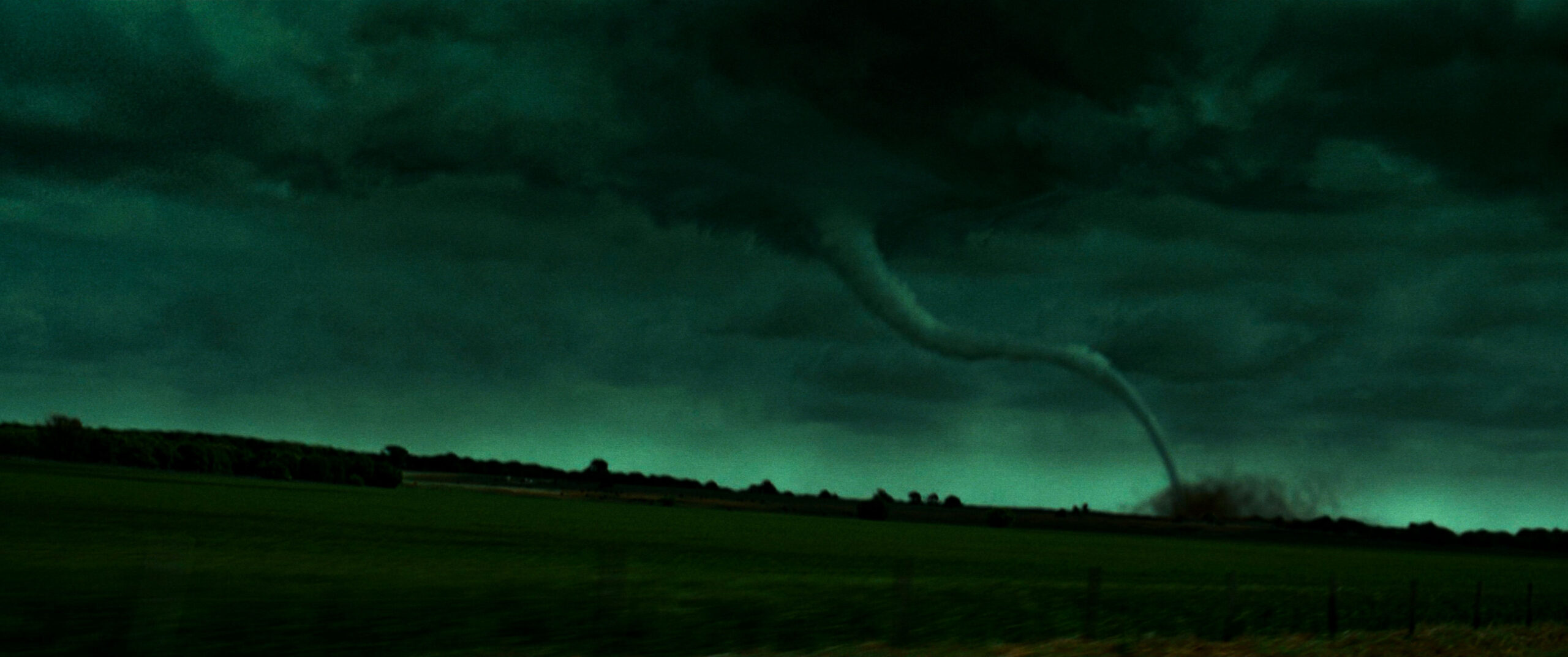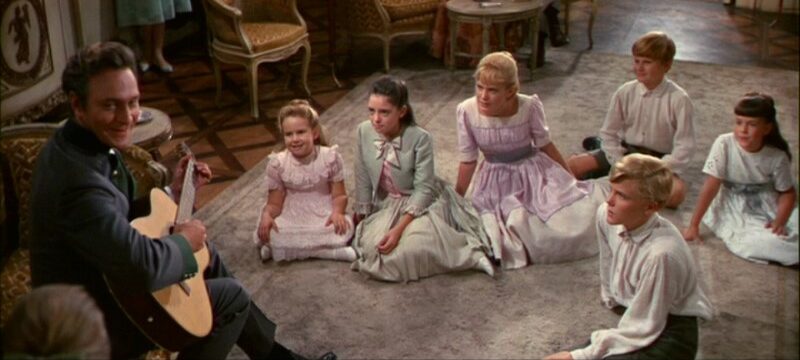**/**** Image B+ Sound A Extras C+
starring Helen Hunt, Bill Paxton, Jami Gertz, Cary Elwes
screenplay by Michael Crichton & Anne-Marie Martin
directed by Jan De Bont
by Bill Chambers Jan De Bont’s Twister has a host of problems that mocking its physics–a common pastime among smartasses the summer of its release–doesn’t begin to address, though if the film were even one degree more earnest than it is, moments like the bit where a tornado powerful enough to hoist a tractor leaves two people clinging tenaciously to a wooden support beam under a rickety bridge unscathed would make for prime “MST3K” fodder. (That’s the thing about notorious pedant Michael Crichton, who co-wrote Twister with then-wife Anne-Marie Martin: he figures getting the technobabble right buys him more poetic license than it really does.) For starters, Helen Hunt doesn’t belong in this milieu–and by that I mean the film’s, not that of the blockbuster. (I actually thought she acquitted herself fine in What Women Want and Cast Away.) Blame the contemporary compulsion to spell everything out: The picture saddles her character, Dr. Jo Harding, with a Tragic Past™ so that she’ll have a psychological motivation for chasing twisters, something that is not only completely gratuitous but also forces us to consider her provenance in a way that would never be an issue had the film stuck to the present tense. It’s impossible to imagine the immutably bicoastal Hunt as the Midwest offspring of the rednecks who leave an indelible impression in the opening flashback, and as a result, she wanders through Twister a virtual impostor.
Retroactively, the presence of Philip Seymour Hoffman has become similarly distracting (this might be his only legitimately bad performance); I know executive-producer Steven Spielberg prides himself on a kind of prescience when it comes to casting bit parts, but it puts him at constant risk of looking like all those directors who squandered Marilyn Monroe early in her career. Hoffman plays, as SLANT’s Eric Henderson brilliantly puts it, one of Jo’s “motley band of Sherwood Forest potheads and meteorology school dropouts,” who’ve got an Acme secret weapon (nicknamed Dorothy, natch) with which they plan to revolutionize tornado research. As luck would have it, the morning of Dorothy’s launch Jo’s estranged husband Bill (Bill Paxton, seemingly a “Bill” as often as Tony Danza is a “Tony”) returns seeking a divorce, his Ralph Bellamy-dumb fiancée (Jami Gertz) in tow. What follows is a not-so-metaphorical day of weathering storms–marriage counselling by way of Mother Nature as Bill and Jo pursue the holy grail of cyclones, the F5 that killed her daddy (not literally, but yeah, literally), with the intention of feeding it electronic doodads from a tin can that will apparently yield an unprecedented amount of scientific data. Surely the only movie to ever suggest a dumbed-down His Girl Friday, Road Runner cartoon, and The Abyss simultaneously, Twister, like the latter film, features a superfluous human antagonist named Jonas (Cary Elwes), a sneering but ultimately innocuous villain in the Jay Ward mold. I’m reminded of Joe Dante’s review of Live and Let Die, in which he wrote that BigBad Kananga “hardly seems to deserve his horrible fate.” Jonas is offed in one of those annoying displays of big-studio hypocrisy–y’know, because he’s slicker and better funded than our underdog heroes.
Still, I suppose it would be a more offensive example of Hollywood’s deluded self-image if Twister weren’t, figuratively speaking, the Last Amblin Movie–the last film to serve as a repository for Spielberg’s fetishes, including but not limited to alien encounters, Ahab-ian quests, houses that collapse on themselves, drive-in theatres, absent fathers, ragtag adventurers, transfixed bystanders (at the risk of piling on Hunt, she unfortunately can’t stare at a tornado in glazed awe without it being vaguely condescending), blatant product placement, and blinding flashes of light. Once Spielberg assumed a corporate identity, so, too, did his productions cease to bear his personal stamp, and it’s instructive to compare this film to the one De Bont directed for Spielberg three years later under the DreamWorks aegis, the stiffly chic The Haunting. But though Twister‘s aesthetics may stir pangs of nostalgia today, the truth is that back then they were just lipstick on a pig. And I suppose that’s still true, except that something about having a Republican in office makes said lipstick a much brighter shade than it had become during the Clinton administration, when the cocoon of Spielbergian wonder seemed so much more unwarranted. Twister may be ersatz all the way–it finally, fatally lacks Spielberg’s fluid grace–but its once-tired idiosyncrasies have a renewed soulfulness, and as someone reared on the teat of Amblin, I have to admit I found myself strangely pacified by it this time around.
Twister‘s Blu-ray debut comes highly anticipated by home-theatre geeks, as the LaserDisc and DTS DVD were both big demo items in their day. Although it would be an overstatement to say “brace yourself for disappointment,” the 2.40:1, 1080p transfer falls short in some ineffable way. There’s a disconcerting softness to the image that goes beyond the expectedly-diffuse anamorphic photography–skin tones, especially, have a botoxed quality in close-ups, and while this doesn’t affect fine detail per se, coarser textures appear a little too smoothed-out. This is also one of those cases where HD brings things into relief the filmmakers clearly counted on flickering projection and video’s low resolution to obfuscate, such as a few frames of the prologue that are optically frozen to lengthen the delay between strikes of lightning. That said, I have every confidence in calling this A/V presentation definitive–and yes, even downmixed by my hoary receiver, the BD’s 5.1 Dolby TrueHD audio boasts a sonic heft that transcends the innate limitations of home theatre. Twister‘s dizzyingly discrete soundmix hasn’t aged a day; as De Bont says in the supplementals, each tornado was given its own unique “voice,” and here the effort is fully rewarded for perhaps the first time since the picture’s theatrical release.
On another track, De Bont and visual effects supervisor Stefen Fangmeier fight a losing battle against the movie proper for attention thanks to the stupid decision to have their voices occupy the left and right channels, respectively, and let the film’s inherently loud soundtrack flood the surrounds. Sadly, the remaining supplements, mastered in 480i across the board and 16×9-unfriendly to boot, aren’t much compensation. Laurent Bouzereau’s typically superficial retrospective doc “Chasing the Storm: Twister Revisited” (29 mins.) finds only one cast member (Paxton) going on record and is dominated by shop-talk from the effects guys aiming to consecrate the film’s place in history as a breakthrough for CGI. Some of the B-roll–like a glimpse of the two Boeing 747 engines used to blow debris across the set–is cool, though Bouzereau is curiously infatuated with a shot of De Bont in a screening room that’s almost always excerpted without context. Narrated by Paxton in the style he reserves for James Cameron documentaries, the vintage HBO featurette “The Making of Twister” (13 mins.) is meanwhile far more promotional in nature and all but cancels out the attendant “Anatomy of a Twister” (9 mins.). Rounding out the infotainment portion of the extras is “Nature Tech: Tornadoes”–45 minutes of wind porn courtesy The History Channel. Special features finish off with two previews for Twister (the trailblazing teaser and standard theatrical trailer) plus the hopeless video for Van Halen‘s “Humans Being.” Where’s Shania?
113 minutes; PG-13; 2.40:1 (1080p/VC-1); English 5.1 Dolby TrueHD, English DD 5.1, French DD 5.1; English, French, Spanish subtitles; BD-50; Region-free; Warner




![Twisters (2024) [Collector's Edition] - 4K Ultra HD + Blu-ray vlcsnap-2024-10-24-15h48m17s041](https://filmfreakcentral.net/wp-content/uploads/2024/10/vlcsnap-2024-10-24-15h48m17s041.png)